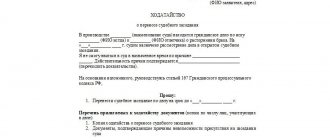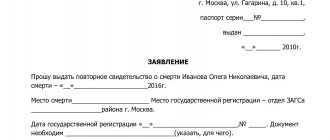Separation, especially after many years of marriage, is a difficult period in a person’s life. If the spouses separated without making claims to each other, and they do not have children, the issue can be resolved in a simple way - through the Wedding Palace. But most unions today are dissolved in the courtroom. A person’s task in such a situation is to seek help from the relevant authorities, obtain a court decision on divorce and pick up a divorce certificate. Just what to do next, and what to do if the plaintiff does not give consent?
If the family has children under 18 years of age, and the spouses cannot divide the acquired wealth and agree on the amount of alimony, the divorce process becomes a complex procedure.
Main provisions of the court verdict
A sample court decision on divorce is a document that confirms the administration of justice in the case. The procedure begins after the claim is transferred to the office of the judicial authority. The presented act has specific properties and characteristics.
- Enforceability. Means that the court translates an abstract legal norm into material properties. That is, the court is an instrument that gives the right the opportunity to exist in reality.
- Specific case. The decision will not address multiple legal situations.
- Commitment. Some time after the decision is made, it comes into force. Everyone who has anything to do with this will now obey him.
- Irrefutable. If the time set by the judicial authorities for appealing the case has expired, the decision will not be changed.
A court decision to terminate a marriage consists of two options:
- written form;
- electronic form (the court must send a sample via the Internet to the post office).
Important: If one of the spouses is a foreigner, then the divorce procedure is no different from the divorce process of two citizens of the Russian Federation!
Why do you need a document from the court?
All citizens of the Russian Federation have the legal right to enter into and dissolve a marriage at any time. To do this, a corresponding application is submitted to the registry office or to the court. After the end of the trial, the court issues a ruling. According to the current legislation of the Russian Federation, this document comes into force 10 days after the court decision is made. After this time, the spouses can receive a divorce decree.
Before the document enters into legal force, each party can challenge the court decision by filing an appeal. Then the document is postponed for the time necessary to consider the materials provided for appeal, and comes into force after the end of the process.
A court decision is an official document that legally confirms the termination of a marriage between spouses.
It contains the following information:
- The full name of the court where the case was heard.
- The names and initials of the judges involved in the divorce proceedings.
- Date and case number.
- Formulation of the decision.
- Judgment date.
- Judge's signature.
- Seal.
Time limit for appeal by the dissenting party
In order to obtain a court decision on divorce (sample) in Russia, you need to wait until the verdict receives legal force. The conditions set out in Russian law state that the verdict cannot take effect immediately.
This gives the losing party the opportunity to correct their situation if it was due to error by the judge, legal representative or lack of evidence. The appeal period varies depending on the type of court and the decision made.
If the dispute was resolved in absentia, since the defendant or plaintiff were not personally present at the consideration of the case, then the law changes the established procedure for appeal. The defendant can also send to the court or personally bring an application with a request to reconsider the previously made decision.
The nuances of divorce
Russian legislation tries to protect the institution of the family, so the divorce procedure is very nervous and protracted. In addition to mental anguish, you will also have to go through several stages of paperwork and visit different authorities. Litigation under Art. 19 and art. 21 of the Family Code of the Russian Federation is carried out if:
- There is a minor child.
- One party or the other does not want to get a divorce.
- There is no agreement regarding the division of joint property.
In the first case, the decision on divorce in court has some features. The following issues need to be addressed:
- establishing the place of residence of the child/children until adulthood;
- purpose and procedure for payment of funds (alimony).
The conflict of interests under the third point is resolved in the established judicial procedure after filing an application or claim in court from the interested party. If a married couple cannot come to an agreement, then, according to Article 24 of the RF IC, the court has the right to make a verdict in accordance with its conclusions.
Let's say that the former couple, in addition to movable and immovable property, also has loan obligations. Loan payments must be made in proportion to the equity participation. If one of the parties refuses to repay the loan, the other party must provide the necessary facts and prove that the funds taken on loan were spent on the needs of the family and by mutual agreement.
If at the time of marriage, a marriage contract was concluded, but some points were not specified in it, then the spouses will have to resolve all these points in accordance with a court ruling.
The plaintiff personally submits the application to the court, which is located at the official place of residence of the opponent. If it is very far away or the plaintiff has minor children or serious illnesses, the application is submitted to his actual address. There is another way to file an application for divorce - since 2021, the online resource State Autonomous System “Justice” has been operating. The service is provided free of charge.
Application form
In order for the marriage to be dissolved in court, the plaintiff submits an application. Before writing an application, you need to go through 3 important stages.
- Choose a court. Often the plaintiff files an application at the place of registration.
- Pay the state fee. Payment information is available on the website of the selected judicial institution.
- Do the documentation.
A sample application for a court decision on divorce is divided into 3 parts. The first is the introduction. This is a mandatory part of any application. It is written in a column on the right side of the page and includes:
- name of the judicial authority;
- information about where the claim is being filed;
- initials and residential address of the defendant and the applicant.
Next comes the main part. It describes all the facts and circumstances why the divorce was decided and provides evidence, if any. For example: infidelity, disagreements, violence, regular alcohol consumption. The plaintiff, describing the motives, attaches evidence (photos, videos, tape recordings) or links to legal norms.
The third part is a request. An important part of the application, because the contents indicate the applicant’s demands, in this case – divorce.
When all the points are outlined, a list of attached documents is compiled. Afterwards the date and autograph, which has a transcript, is indicated. The list of documents that the plaintiff must present along with the application includes:
- a copy of the claim for the spouse (defendant);
- two certificates: wedding and birth certificates of common minor children (if any);
- a certificate of income of both the plaintiff and the defendant (if there are children and the item on payment of alimony was selected in the application);
- other official papers.
Which court should I file for divorce in?
After the statement of claim is ready, it is necessary to determine which court to send it to. The application can be sent to:
- to the court at the place of registration of the defendant;
- to the court at the place of registration of the plaintiff (if he has a disability or small children).
How is the trial going?
5 days after the court receives the documents, a decision is made to accept the case for consideration. But if the judge finds errors in the documents, he will return the claim to the applicant for revision.
As practice shows, the most popular reason for a return is sending a copy of the marriage certificate. And for a divorce, you must provide the original.
If the documents are normal, the judge sets a date for the preliminary hearing. The date is selected within 2 weeks of consideration of the application. The court clerk will call the participants in the process and notify them of the date of the preliminary hearing.
On the appointed day, the parties must appear before the judge. If the plaintiff confirms his claims, then a date for the main hearing is set. In this case, the judge may request additional documents from the defendant. They depend on his position on the plaintiff’s demands.
On the day of the hearing, the judge considers not only the issue of divorce, but also additional requirements. Therefore, the trial may drag on. In practice, a dispute over divorce and division of property can last 6 or more months.
The final decision will be made when the judge decides on all the claims in the lawsuit.
Example of a court decision to terminate a marriage
According to the law, a decision on divorce (sample) must be presented in writing and with special content.
This document has a general structure and consists of 4 parts. They are regulated by law and are specified in Article 197 of the Code of Civil Procedure of the Russian Federation. The first part is introductory. It indicates the name of the judicial body, the initials of the judge or several, the secretary and the prosecutor, if he participated in the meeting. The initials of both parties to the dispute are also recorded.
The second part is descriptive, including claims and supporting circumstances. The position of the defendant is also described. If he does not agree with the divorce, motives and arguments are indicated. If during the course of the case the applicant changed his testimony or there was a reconciliation between the parties, they will also be presented in this part.
The third is the motivational part, which includes conclusions about the case. The contents indicate the evidence and circumstances justifying the decision of the chief judge or arguments if the claims were rejected. The essence of the motivational part is not described in detail if the defendant agrees with the final verdict.
The fourth is called the operative part. This is an important stage that includes the full outcome of the trial. The conclusions are presented in a concentrated and final form.
Consideration of the case by a magistrate
If the statement of claim is drawn up and executed correctly, all necessary documents are attached, the judge is obliged to consider the issue of accepting it for trial within 5 days. A ruling on this is made, on the basis of which a civil case is initiated. Also, after accepting the application, the judge makes a ruling on preparing the case for trial and indicates the actions that the parties should take and the timing of these actions to ensure the correct and timely consideration and resolution of the case.
The magistrate's ruling on accepting the application for court proceedings and preparing the case for trial
The judge, having recognized the case as prepared, issues a ruling to appoint it for trial at a court hearing, notifies the parties of the time and place of consideration of the case by:
- serving a subpoena in court;
- sending the summons by registered mail with acknowledgment of delivery;
- SMS alerts.
Subpoena
Features of filing a claim
The court is divided into two types: district and world. The first type deals with divorce proceedings if serious disagreements have arisen in the family regarding the division of jointly acquired property. The same court considers the case if the parents cannot decide on the place of residence of the offspring.
The main feature of divorce through the court is the chance to submit an application and the necessary documents unilaterally. First, citizens collect originals and copies of passports, identification numbers, marriage certificates and documents on the birth of children. Then a claim is filed and the tax is paid. When everything is done, the papers and receipt for payment of the state duty are transferred to the court office.
The time frame for consideration of the case is set individually for each family, taking into account the seriousness of the dispute and the circumstances. If the application for divorce is drawn up correctly, the divorce process will speed up. In order not to miss important points, it is recommended to contact a competent lawyer who considers not only the divorce case, but also the division of property. It is good if the couple can peacefully agree on the payment of alimony, the division of property and the place of residence of the children.
Default judgment
It often happens that divorce proceedings take place in the absence of the defendant.
This behavior of a citizen may be caused by the following reasons:
- A person does not want to lose his family and does not want to sort things out in court. In such a situation, it is better to overcome yourself and come to the meeting to express your position regarding divorce. The failure of the defendant to appear in the courtroom without a good reason will not save him from divorce - the decision will be made in absentia.
- One of the spouses is on a long business trip, lives in another country, or is unable to attend court hearings for health reasons. In such circumstances, the defendant can send his consent to the dissolution of the family union, certified by a notary. He can give the document to the plaintiff or send it to the court office.
- The citizen simply does not know about the divorce process. This is a fairly common situation when the applicant, not wanting to meet his other half again, tries to arrange the divorce case in such a way as to obtain a divorce decree without unnecessary hassle. But if it turns out that the plaintiff deliberately concealed from the spouse the fact of the beginning of the divorce process, this may become the basis for the cancellation of the court decision. But in fairness, it is worth noting that such precedents happen extremely rarely.
Ways to obtain a certificate
The plaintiff or defendant has the right to be present in person, to delegate his legal representative or to present a document stating the reason for failure to appear.
Each party may indicate in the application a request to send an example of a court decision on divorce to an email address. To do this, the court must have the appropriate capabilities.
A judicial act will be issued only if the initiator’s demands are met. The RF IC sets out two methods for issuing an extract from a court decision.
- The citizen who took part in the trial independently picks up the document.
- A citizen who does not appear at the hearing may receive a verdict by mail. This will take up to 5 days.
Once the court has made its decision, the two civil parties receive a deed, but it has not yet entered into force. This allows the dissenting party to take action regarding the appeal. The act will indicate the period within which the decision is allowed to appeal. Typically this period is 1 month.
When the divorce process has taken place and an agreement has been reached, the former spouses receive a certificate stating that the marriage is dissolved. The decision comes into force 30 days after the meeting and the verdict. A copy of the decision must be taken to the registry office, and they will issue a certificate of divorce.
Who is eligible to receive?
The extract will be issued only to the participant in the process, that is, the former spouses. Each of the former couple has the right to draw up a power of attorney with a notary for his representative, who will also be given the paper.
The amendment and termination of a marriage contract occurs in court. When can a marriage be declared invalid and how does this procedure occur? Find out about it here. Are you getting married and want to take your husband's last name? A sample application for a change of surname is in our article.
Discontinuation of production
At any time before the decision is made, the spouses can reconcile or change their mind about getting a divorce. In this case, the plaintiff must abandon the claim by sending an appropriate statement or petition at the court hearing. In such circumstances, the judge issues a ruling to terminate the proceedings and returns the original marriage certificate to the plaintiff. And only holes in the certificate from sewing into the case materials will remain a reminder of the desire to get a divorce.
Court ruling on termination of proceedings due to reconciliation of the parties






